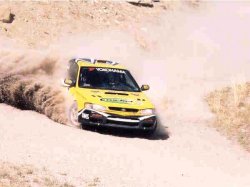 |
|||||||||||
|
|
|
|
||||||||
WCRA
website promoting Stage and TSD Rally Sport in
British Columbia |
|
||||||||||||||||||
|
||||||||||||||||||
| What is Performance or Stage Rally? Performance Rallying has long been a favorite form of motor sport in Europe, Asia, Africa and other parts of the world. In these places, rallies often draw crowds in the tens of thousands. Unlike conventional racing, rallies are held primarily on forest access roads. These roads consist of everything from loose gravel to mud or snow and ice. The conditions can dictate speeds from well over 200 km/h to as low as 30 km/h. Also, unlike racing, the route remains unknown to the driver until it is read at speed by the CO-driver (navigator). At every moment, the car, driver and CO-driver must be ready for whatever may be around the next curve! Performance Rallying displays a unique combination of driver skill, car performance, strategy, endurance and pure guts. The Performance Rally format consists of two parts: Special Stages and Transit Sections. The Special Stages are the competitive sections of the route and are closed to public traffic during the event. These are flat-out runs against the clock, at speeds that the average motorist would never imagine possible. The Transit Sections are routes between Stages, in which the teams must obey all traffic laws. Ample time is provided to allow teams to arrive at the start of the next Stage without speeding, and penalties are assessed for arriving too early or too late. Any moving violation in a transit section is grounds for disqualification. The accumulation of times from the Special Stages and transit penalties makes up the final score and helps to determine the winner. Performance Rally vehicles require certain safety
equipment to protect the crew. This includes a
full roll cage, with door bars and triangulation,
fire extinguishers and special seat belts. The
crew must wear approved fireproof suits and helmets,
and must hold a St. John Ambulance First Aid certificate.
All of this equipment is scrutinized by event
officials before the start of each event. |
||||||||||||||||||
| What is Navigational or Time-Speed-Distance (TSD) Rally? Would you like to be in competition for a whole day with minimal time spent in preparation and only normal wear and tear on your car?..then Navigational rallying is for you! It's likely the least expensive form of amateur motorsport. Navigational Rallying has been practiced in Canada
since the early 1950's, and tests both driver
and navigator. Instead of running flat-out, as
in a performance rally, navigational events use
the Time-Speed-Distance (TSD) formula. In a TSD
section, a particular average speed is listed
and the teams must drive as close as possible
to that speed. Checkpoints are placed at unknown
locations in the TSD section and teams are penalized
for passing them early or late. Average speeds
are always within posted speed limits, and the
road is not closed to the public, so teams must
obey all traffic laws. The route usually follows
roads that are similar to those used in performance
rallies: narrow winding forestry roads, ranch
roads and other less-traveled roads. Route finding
is generally not difficult, but the navigator
has a lot of work to do to keep the driver on
time. |
